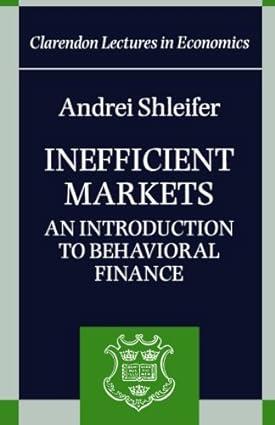Question
Warrant/Convertible decisions The Howland Carpet Company has grown rapidly during the past 5 years. Recently, its commercial bank urged the company to consider increasing its
Warrant/Convertible decisions
The Howland Carpet Company has grown rapidly during the past 5 years. Recently, its commercial bank urged the company to consider increasing its permanent financing. Its bank loan under a line of credit has risen to $250,000, carrying an 8% interest rate. Howland has been 30 to 60 days late in paying trade creditors.
Discussions with an investment banker have resulted in the decision to raise $500,000 at this time. Investment bankers have assured the firm that the following alternatives are feasible (flotation costs will be ignored).
- Alternative 1: Sell common stock at $8.
- Alternative 2: Sell convertible bonds at an 8% coupon, convertible into 100 shares of common stock for each $1,000 bond (i.e., the conversion price is $10 per share).
- Alternative 3: Sell debentures at an 8% coupon, each $1,000 bond carrying 100 warrants to buy common stock at $10.
John L. Howland, the president, owns 80% of the common stock and wishes to maintain control of the company. There are 100,000 shares outstanding. The following are extracts of Howland's latest financial statements:
| Balance Sheet | ||||
| Line of credit | $250,000 | |||
| Other current liabilities | 150,000 | |||
| Long-term debt | 0 | |||
| Common stock, par $1 | 100,000 | |||
| Retained earnings | 50,000 | |||
| Total assets | $550,000 | Total claims | $550,000 |
| Income Statement | |
| Sales | $1,100,000 |
| All costs except interest | 990,000 |
| EBIT | $ 110,000 |
| Interest | 20,000 |
| Pre-tax earnings | $ 90,000 |
| Taxes (25%) | 22,500 |
| Net income | $ 67,500 |
| Shares outstanding | 100,000 |
| Earnings per share | $ 0.68 |
| Price/earnings ratio | 12.67 |
| Market price of stock | $ 8.55 |
-
Show the new balance sheet under each alternative. For Alternatives 2 and 3, show the balance sheet after conversion of the bonds or exercise of the warrants. Assume that half of the funds raised will be used to pay off the bank loan and half to increase total assets. Do not round intermediate calculations. Round your answers to the nearest dollar. If an amount is zero, enter "0".
Balance Sheet Alternative 1 LOC $ Other current liabilities $ Long-term debt -- Common stock, par $1 $ Paid-in capital $ Retained earnings $ Total assets $ Total claims $ Balance Sheet Alternative 2 LOC $ Other current liabilities $ Long-term debt -- Common stock, par $1 $ Paid-in capital $ Retained earnings $ Total assets $ Total claims $ Balance Sheet Alternative 3 LOC $ Other current liabilities $ Long-term debt (8%) $ Common stock, par $1 $ Paid-in capital $ Retained earnings $ Total assets $ Total claims $ -
Show Mr. Howland's control position under each alternative, assuming that he does not purchase additional shares. Do not round intermediate calculations. Round your answers to the nearest whole number.
Original Plan 1 Plan 2 Plan 3 Number of shares Total shares Percent ownership % % % % -
What is the effect on earnings per share of each alternative, assuming that profits before interest and taxes will be 20% of total assets? Do not round intermediate calculations. Round your answers to the nearest cent.
Alternative 1 $ Alternative 2 $ Alternative 3 $ -
What will be the debt ratio (TL/TA) under each alternative? Do not round intermediate calculations. Round your answers to the nearest whole number.
Alternative 1 % Alternative 2 % Alternative 3 %
Please help and show work.
Thank you
Step by Step Solution
There are 3 Steps involved in it
Step: 1

Get Instant Access to Expert-Tailored Solutions
See step-by-step solutions with expert insights and AI powered tools for academic success
Step: 2

Step: 3

Ace Your Homework with AI
Get the answers you need in no time with our AI-driven, step-by-step assistance
Get Started


